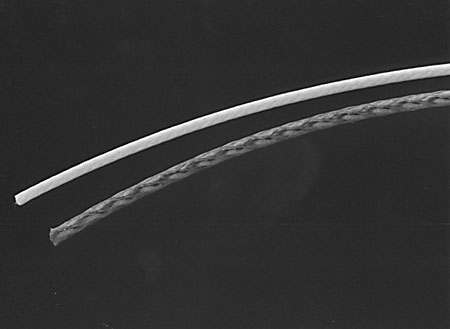|
|

Thin And Loose, Or Thick And Tight?
 By Steve Crandall
By Steve Crandall
Vice President, Sales & Marketing
Ashaway Racket Strings
In previous columns we looked at string gauge, or thickness, and string tension, and we saw how these qualities work independently. Now we're going to put them together, to see how string gauge and tension relate to one another. The issue is complex enough so that we will begin the discussion here, and finish up in the next issue.
As we have already seen, strings at low tension provide more power than strings at high tension. Many people think it works the other way around, but you know better. At lower tension, a string can stretch more when it hits the ball. Stretch and rebound, which we call the trampoline effect, provides the power. On the other hand, tight strings remain flatter when you hit the ball, which provides better control.
Thinner strings are naturally more elastic than thicker ones, which is why they tend to be more powerful than thick strings: more stretch equals more power. But here's where it gets tricky: stringing a racquet with 15 gauge (thick) string at 35 lb. of tension stretches the string just a little. Stringing the same racquet with 18 gauge (thin) string at 35 lb. of tension stretches the string a lot-maybe close to its maximum elongation.
Hence, we have the idea of "relative tension," by which a thin string is effectively "tighter" than a thick one at the same pound-tension. They are both held under the same amount of force, but the thinner one is stretched further, so it feels and plays as if it's tighter. (This assumes that all other things are equal: identical racquets, string construction, temperature, etc. Of course, all other things are never really equal, so treat this as a general rule, not holy doctrine.)
Thick strings of 16 or even 15 gauge have been the norm in racquetball, but recently there has been a trend toward thinner strings of 17 or even 18 gauge, in the pursuit of greater power. If you're considering making the change, you'll have to make some adjustments in your stringing habits.
Say you've been relatively happy playing a 16 gauge string at 35 lb. If you now put 18 gauge string in the same racquet at 35 lb., you'll probably lose power rather than gain it. Why? Because the thin string is too stiff at 35 lb. You'll want to reduce the tension to 25 or 30 lb. to provide enough flexibility to equal, or hopefully exceed, the power that you got from the thicker string.
Once you've found the tension at which your racquet generates maximum power for a particular string, you may want to tune the racquet further to suit your style of play. By reducing the tension a few pounds, the string will be less prone to breakage. By raising the tension a couple
pounds, you'll stiffen the string bed: it will remain flatter when you hit the ball, and you'll gain control.
This article previously appeared in Racquetball Magazine.
|